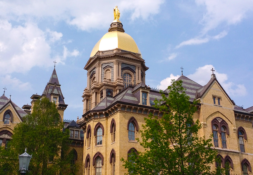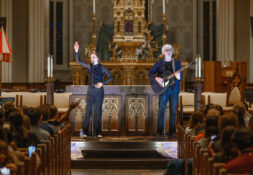Student team learns about fiscal operations, begins work on tuition plan
 At the beginning of Rebecca Blais’ term as student body president, she commissioned the first full student government review of Notre Dame’s financial status. The study’s dual mandate was to provide the student body with a better understanding of the university’s financial operation and to investigate the issue of Notre Dame’s high cost of attendance. Results of the review included: that the university derives the majority of its operating funding from non-tuition sources, a newfound understanding of the role of the endowment, and a conclusion that a student driven plan to reduce the cost of attendance is feasible.
At the beginning of Rebecca Blais’ term as student body president, she commissioned the first full student government review of Notre Dame’s financial status. The study’s dual mandate was to provide the student body with a better understanding of the university’s financial operation and to investigate the issue of Notre Dame’s high cost of attendance. Results of the review included: that the university derives the majority of its operating funding from non-tuition sources, a newfound understanding of the role of the endowment, and a conclusion that a student driven plan to reduce the cost of attendance is feasible.
Executive Controller Alex Kruszewski, the student government’s head financial official, assembled a diverse team of 14 undergraduates, largely finance and accounting majors. The team was divided into the financial transparency committee led by junior Brendan Roche and the financial wellness task force led by sophomore John Cresson. Kruszewski, Roche, and Cresson received the full finance presentation that is given annually by Associate Vice President and Controller Drew Paluf and his team to the Board of Trustee’s fiduciary committee.
The presentation covered topics such as Notre Dame’s outstanding debt, the causes of rising tuition, the sources of Notre Dame’s income, and the status of Notre Dame’s endowment. In addition to this presentation, the taskforce reviewed decades of Notre Dame’s financial statements to analyze major shifts in university expenditures.
The team’s first discovery was that, contrary to the opinion of many students, tuition is not Notre Dame’s primary source of income. While the university’s tuition income was over $607 million in 2017, of that, just under $264 million was tuition scholarships and fellowships awarded by the university. Thus, Notre Dame’s revenue from tuition was just under $320 million dollars, less than thirty percent of Notre Dame’s $1.1 billion operating expenditures. The remaining expenditures are covered by largely by endowment earnings, which contributed $500 million, and auxiliary operations, which contributed $270 million.
Additionally, the team concluded that Notre Dame’s works to operate in a financially conservative manner through policies such as refraining from beginning new construction until it has raised 75% of the construction cost. Moreover, the university focuses on establishing perpetuity endowments in which only investment earnings, rather than the endowment principle, is spent. This allows the university to ensure that its endowment will be able to provide sustained revenue for the university. Thus, the success of Notre Dame’s endowment investments, led by Vice President and Chief Investment officer Scott Malpass and his team, is of vital importance to Notre Dame.
In an email interview with the Irish Rover, Kruszewski emphasized the importance of Malpass’ work to Notre Dame, remarking “[t]he water that runs through our showers, the food students eat at the dining hall, the professors who teach us, the workers who cut the grass, all are financed by money earned from a desk in a little corner office on Eddy Street that [Chief Investment Officer Scott] Malpass sits at. We do not give him nearly enough credit.”
Kruszewski also commented to the Irish Rover that “Notre Dame is sensitive to outside occurrences, especially those by the federal government as they pertain to endowment taxation but that the leadership of the Board of Trustees fiduciary committee, Drew Paluf, and Scott Malpass is such that there really are not large concerns. We are lucky to have incredible financial leadership taking the proper precautions.” However, he would not reveal what precautions those are.
On the review as a whole, Cresson remarked to the Irish Rover that “the meeting [with Paluf and his team] was very productive and transparent. They helped us to better understand Notre Dame’s finance so we could be confident in them and pass that confidence on to the student body.”
Cresson, Kruszewski, and Roche report that they have begun using their new knowledge of university financials to draft a plan for tuition reduction. Kruszewski reports “[o]ur goal is simple. We will have a developed and feasible plan to reduce tuition and to increase the number of students covered by financial aid, approved by financial leaders in the administration and on Father Jenkin’s desk by this summer.” Among the university officials with which Kruszewski’s team is working are Malpass, Executive Vice President John Affleck-Graves, and Director of Financial Aid Mary Nucciarone.
Regarding the student teams work with university officials, Blais told the Irish Rover that “[w]e’re excited that the team has this opportunity to work with members of the administration on such a pertinent issue. We are all interested in learning from the results and exploring ways to further grow student involvement in this area.”
When pressed for details regarding the plan, Kruszewski demurred but revealed that it would be focused on establishing earmarked endowments to cover specific operating expenses currently covered by tuition. Tuition would then no longer need to cover those expenses and could then be lowered.






Leave a Reply